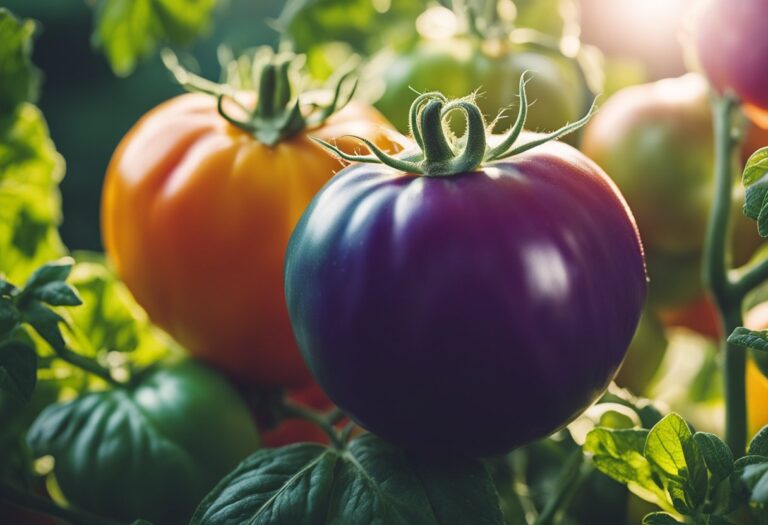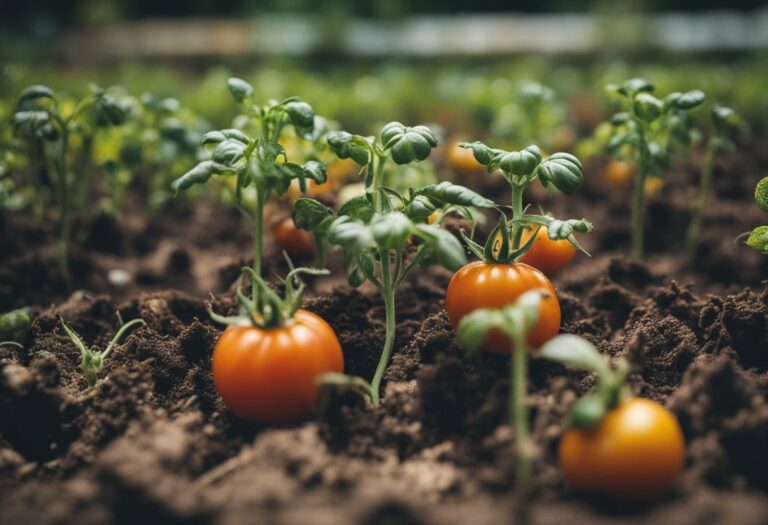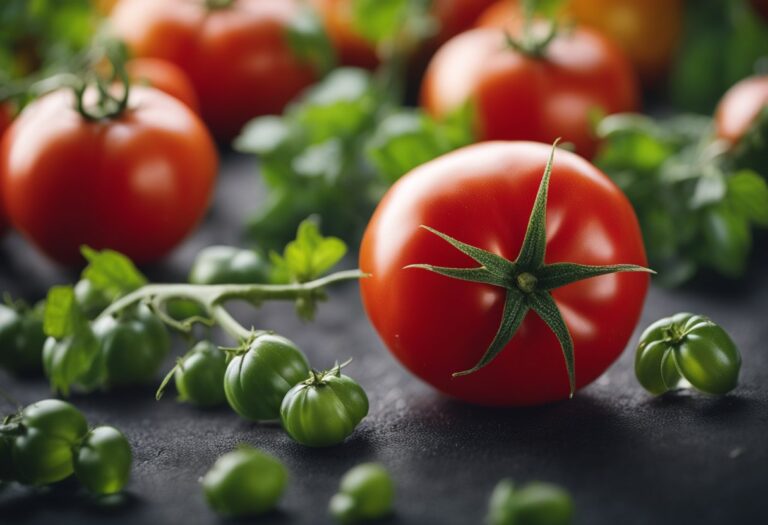Rainbow Siberian Tomato: A Colorful Addition to Your Garden
If you’re looking for a unique and eye-catching tomato variety to add to your garden, the Rainbow Siberian Tomato might just be the perfect choice.
This mid-season variety produces bicolored tomatoes that are both beautiful and delicious.
With its origins in a cross between OSU Blue and Beauty King tomatoes, the Rainbow Siberian Tomato has become a popular heirloom variety among gardeners.
Mark McCaslin created the Rainbow Siberian Tomato by crossing two different tomato varieties. This resulted in a tomato that is both beautiful and flavorful.
The Rainbow Siberian Tomato has become a popular heirloom variety among gardeners due to its unique appearance and taste. It is a mid-season variety that produces bicolored tomatoes that are both beautiful and delicious.
When it comes to growing Rainbow Siberian Tomatoes, there are a few things to keep in mind. These tomatoes are unique in their tolerance of cool conditions, relative to other tomatoes.
They can be successfully germinated at slightly lower temperatures than other varieties that typically need a starting medium temp of 75 degrees F or higher. Additionally, Siberian tomatoes can be grown in a shorter growing season, typically requiring around 50 to 60 days to mature.
Key Takeaways
- Rainbow Siberian Tomato is a mid-season variety that produces bicolored tomatoes that are both beautiful and delicious.
- The Rainbow Siberian Tomato was created by crossing OSU Blue and Beauty King tomatoes.
- Rainbow Siberian Tomatoes are unique in their tolerance of cool conditions, can be grown in a shorter growing season, and require a slightly lower germination temperature than other tomato varieties.
Rainbow Siberian Tomato: An Overview
If you’re looking for a unique and eye-catching tomato to add to your garden, the Rainbow Siberian Tomato may be just what you need.
This mid-season variety was developed by crossing OSU Blue and Beauty King tomatoes and produces bicolored tomatoes that are just as beautiful on the inside as they are on the outside. Here’s everything you need to know about growing and enjoying Rainbow Siberian Tomatoes.
Characteristics
Rainbow Siberian Tomatoes are a great choice for gardeners who live in cooler climates. They are more tolerant of cool conditions than other tomato varieties, and they can be successfully germinated at slightly lower temperatures. Additionally, they can be grown in a shorter growing season than other tomatoes.
These tomatoes are mid-sized, with a globe-shaped fruit that weighs around 5 ounces. They are bright red with a yellow or orange blush, and they have a sweet and tangy flavor. The flesh is juicy and meaty, making them perfect for fresh eating, salads, and sandwiches.
Growing Tips
If you want to grow Rainbow Siberian Tomatoes, here are a few tips to help you get started:
- Start seeds indoors 6-8 weeks before the last frost date in your area.
- Transplant seedlings outdoors after all danger of frost has passed and the soil has warmed up.
- Plant in full sun in well-drained soil that has been amended with compost or other organic matter.
- Water regularly, but avoid getting water on the leaves to prevent fungal diseases.
- Fertilize every few weeks with a balanced fertilizer to encourage healthy growth.
- Pinch off suckers that form in the leaf axils to direct the plant’s energy into fruit production.
Culinary Uses
Rainbow Siberian Tomatoes are versatile and can be used in a variety of dishes. They are perfect for slicing and adding to salads or sandwiches, but they can also be roasted, grilled, or sautéed.
The sweet and tangy flavor pairs well with herbs like basil, oregano, and thyme, and they can be used in sauces, salsas, and relishes.
History and Origin of Rainbow Siberian Tomato
If you’re a tomato lover, you might have heard of the Rainbow Siberian Tomato. This unique variety of tomato is known for its beautiful color and delicious taste. But where did it come from? Let’s take a look at the history and origin of this tomato.
Origin
As the name suggests, the Rainbow Siberian Tomato is believed to have originated in Siberia, a region in Russia.
The tomato was first introduced to the United States in 1984 by William Bonsall, who shared the seeds with the Seed Savers Exchange Yearbook. Since then, the Rainbow Siberian Tomato has become a popular choice among gardeners and tomato enthusiasts.
Appearance
One of the most distinctive features of the Rainbow Siberian Tomato is its appearance. The tomato is medium-sized and has a unique color pattern.
When ripe, the tomato has a deep red color with green stripes. The flesh of the tomato is also a beautiful shade of red, making it a visually stunning addition to any dish.
Taste and Culinary Uses
But the Rainbow Siberian Tomato isn’t just a pretty face. It also has a delicious taste that is both sweet and tangy.
The tomato is perfect for salads, sandwiches, and sauces. It’s also a great choice for canning and preserving, as it holds its shape and flavor well even after being cooked.
Growing Rainbow Siberian Tomato
If you’re interested in growing your own Rainbow Siberian Tomato, you’ll be happy to know that it’s relatively easy to do so.
The tomato is a hardy variety that can grow in most parts of North America. It prefers full sun and well-drained soil, and should be planted after the last frost of the season.
Cultivation Techniques for Rainbow Siberian Tomato
Growing Rainbow Siberian tomatoes is a rewarding experience that can yield juicy and flavorful tomatoes. Here are some cultivation techniques to help you grow your own Rainbow Siberian tomatoes successfully:
Choosing the Right Location
When selecting a location to grow your Rainbow Siberian tomatoes, it’s important to consider the following factors:
- Sunlight: Rainbow Siberian tomatoes require a lot of sunlight to grow and produce fruit. Choose a location that receives at least six hours of direct sunlight per day.
- Soil: The soil should be well-draining and rich in nutrients. If the soil in your chosen location is poor, consider amending it with compost or other organic matter.
- Temperature: Rainbow Siberian tomatoes prefer warm temperatures, so choose a location that is sheltered from cold winds and frost.
Planting Rainbow Siberian Tomato Seeds
Planting Rainbow Siberian tomato seeds is easy. Here are some tips to help you get started:
- Start seeds indoors: Rainbow Siberian tomato seeds can be started indoors six to eight weeks before the last expected frost. Plant seeds in seed-starting soil and keep them moist and warm until they germinate.
- Transplant seedlings: Once the seedlings have grown to about six inches tall, they can be transplanted into your garden. Be sure to harden off the seedlings first by gradually exposing them to outdoor conditions.
- Spacing: Rainbow Siberian tomato plants should be spaced about two feet apart to allow for proper growth.
Caring for Rainbow Siberian Tomato Plants
Caring for Rainbow Siberian tomato plants is relatively easy. Here are some tips to help you care for your plants:
- Watering: Rainbow Siberian tomato plants require regular watering, especially during hot and dry weather. Be sure to water deeply and avoid getting water on the leaves, which can lead to fungal diseases.
- Fertilizing: Rainbow Siberian tomato plants benefit from regular fertilizing. Use a balanced fertilizer every three to four weeks.
- Pruning: Prune your Rainbow Siberian tomato plants to promote healthy growth and fruit production. Remove suckers (the small shoots that grow between the main stem and the branches) and any diseased or damaged leaves.
Harvesting Rainbow Siberian Tomatoes
Rainbow Siberian tomatoes are ready to harvest when they are fully ripe and have a deep red color. Here are some tips for harvesting:
- Timing: Rainbow Siberian tomatoes typically take 60-70 days to mature after transplanting. Check the fruit regularly for ripeness.
- Method: To harvest, gently twist the tomato off the stem or use a pair of scissors to cut the stem.
- Storage: Store Rainbow Siberian tomatoes in a cool, dry place. They can also be stored in the refrigerator for up to a week.
By following these cultivation techniques, you can successfully grow your own Rainbow Siberian tomatoes and enjoy their juicy and tangy flavor.
Benefits and Uses of Rainbow Siberian Tomato
If you’re looking for a tomato that’s both visually stunning and delicious, the Rainbow Siberian Tomato is an excellent choice. Here are some benefits and uses of this unique variety:
- Cold Tolerance: One of the most significant benefits of Rainbow Siberian Tomatoes is their ability to withstand colder temperatures. This makes them an excellent choice for gardeners in colder climates who want to grow tomatoes earlier in the season. They can even be grown in large pots on a patio or balcony.
- Eye-Catching Appearance: Rainbow Siberian Tomatoes are a beautiful bicolored tomato that is sure to catch your eye. They have a lovely blend of red and green colors, making them an excellent choice for adding color to salads and other dishes.
- Great Flavor: Rainbow Siberian Tomatoes have a sweet, tangy flavor that is perfect for eating fresh or using in recipes. They are also great for making sauces and canning.
- Easy to Grow: Siberian tomatoes are relatively easy to grow, making them an excellent choice for beginner gardeners. They have a determinate growth habit, which means they don’t require staking. They also produce a good yield even when grown in a large pot.
- Health Benefits: Tomatoes are an excellent source of vitamins and minerals, including vitamin C, potassium, and lycopene. Lycopene is an antioxidant that has been shown to have potential health benefits, including reducing the risk of heart disease and certain types of cancer.
Overall, Rainbow Siberian Tomatoes are a great addition to any garden or kitchen. They are easy to grow, visually stunning, and delicious. Whether you’re a seasoned gardener or a beginner, these tomatoes are sure to impress.
Common Issues in Growing Rainbow Siberian Tomato
Growing Rainbow Siberian Tomato can be a rewarding experience, but it’s not without its challenges.
Here are some common issues you may encounter when growing these tomatoes and how to address them:
1. Blossom End Rot
Blossom end rot is a common issue that can affect Rainbow Siberian Tomatoes. It’s characterized by a black, leathery spot that appears on the bottom of the fruit. This is caused by a calcium deficiency in the plant.
To prevent blossom end rot, ensure that your plants are getting enough calcium. You can add calcium to the soil by adding crushed eggshells or dolomite lime.
2. Pests
Pests like aphids, whiteflies, and tomato hornworms can be a problem for Rainbow Siberian Tomatoes. To prevent pests, keep your garden clean and remove any debris that could harbor pests.
You can also use companion planting to deter pests. For example, planting marigolds or basil near your tomatoes can help keep pests away.
3. Diseases
Rainbow Siberian Tomatoes can be susceptible to diseases like blight and leaf spot. To prevent diseases, ensure that your plants are getting enough sunlight and air circulation. You can also use a fungicide to prevent the spread of disease.
4. Watering
Overwatering or underwatering can be a problem for Rainbow Siberian Tomatoes. To prevent these issues, ensure that your plants are getting enough water.
You can use a drip irrigation system to ensure that your plants are getting the right amount of water.
5. Temperature
Rainbow Siberian Tomatoes are known for their ability to withstand colder temperatures, but they still need warm temperatures to thrive. If the temperature drops below 50 degrees Fahrenheit, the plants may stop growing and the fruit may not ripen.
To prevent this, ensure that your plants are getting enough sunlight and warmth. You can also use a row cover to protect your plants from cold temperatures.
By being aware of these common issues and taking steps to prevent them, you can ensure a successful harvest of Rainbow Siberian Tomatoes.
Frequently Asked Questions
What is the taste of the Rainbow Siberian tomato?
Rainbow Siberian tomatoes have a sweet and tangy taste, with a subtle smokiness that makes them stand out from other tomato varieties. They are juicy and flavorful, making them a great addition to salads, sandwiches, and other dishes.
How big do Rainbow Siberian tomatoes get?
Rainbow Siberian tomatoes are medium-sized, typically weighing between 6-8 ounces. They are slightly larger than cherry tomatoes but smaller than beefsteak tomatoes.
Are Rainbow Siberian tomatoes edible?
Yes, Rainbow Siberian tomatoes are completely edible and safe to consume. They are a popular choice for home gardeners and chefs alike.
Are Siberian tomatoes similar to Rainbow Siberian tomatoes?
While both Siberian tomatoes and Rainbow Siberian tomatoes are known for their ability to withstand colder temperatures, they are not the same variety.
Siberian tomatoes are typically smaller and have a more acidic taste, while Rainbow Siberian tomatoes are larger and sweeter.
Where can I buy Rainbow Siberian tomato seeds?
Rainbow Siberian tomato seeds can be purchased from a variety of online seed retailers, as well as some local garden centers.
Some popular options for purchasing Rainbow Siberian tomato seeds include Bounty Hunter Seeds and Rainbow Seeds.
What is the growing season for Rainbow Siberian tomatoes?
Rainbow Siberian tomatoes are a mid-season variety, typically taking around 80 days to mature from seed to harvest.
They can be planted in the spring and harvested in the summer or early fall, depending on your location and climate.



